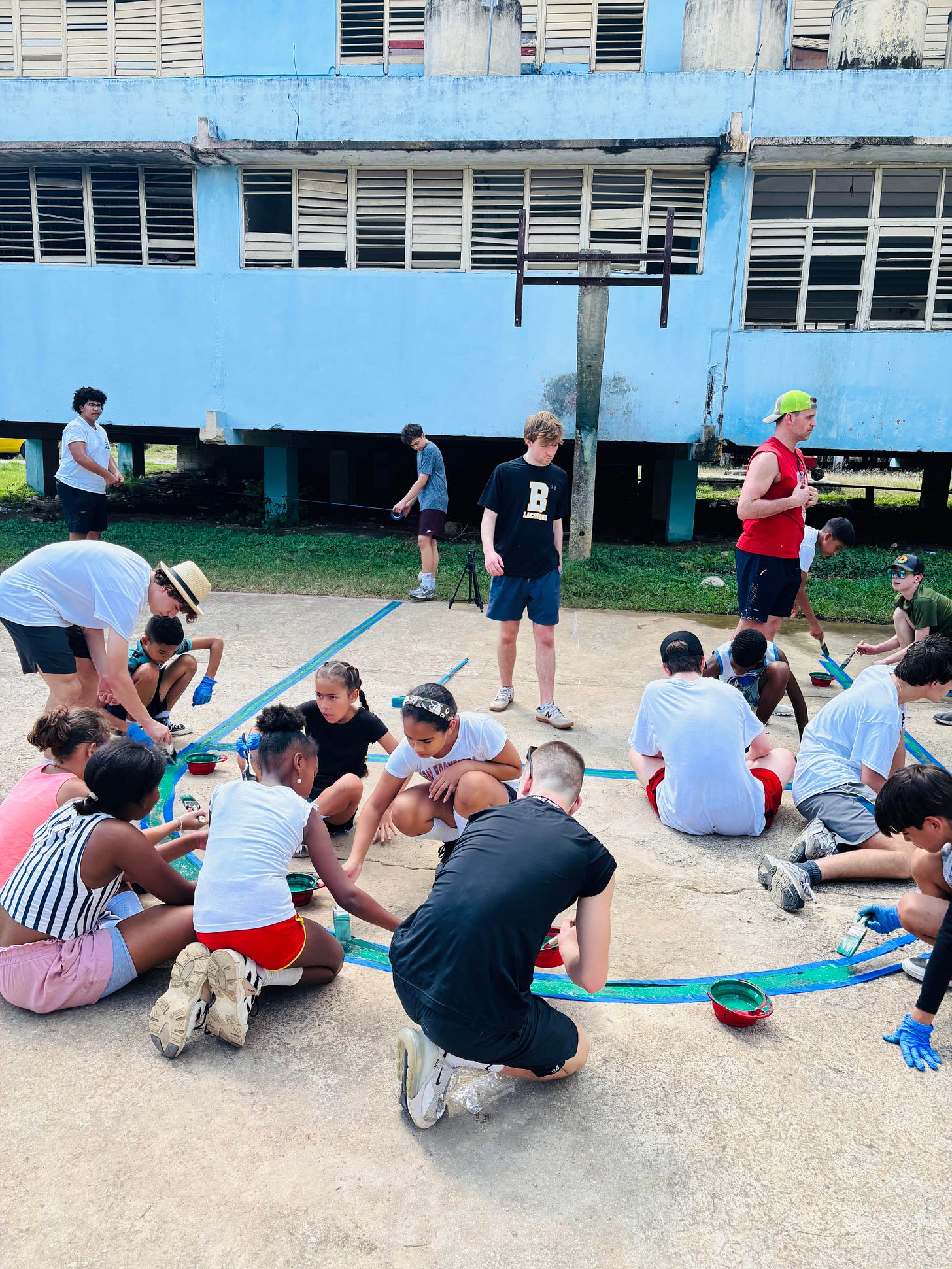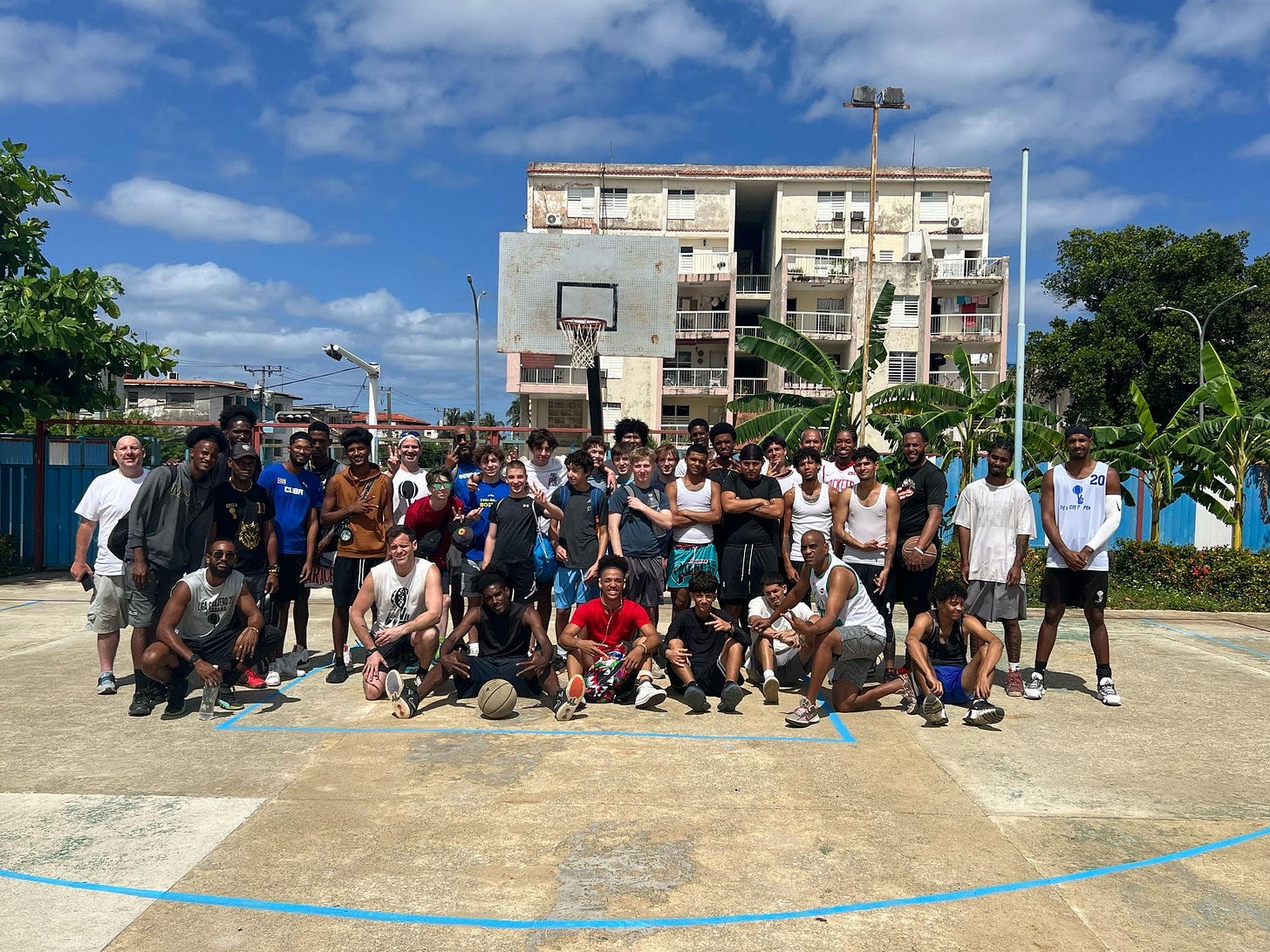Havana, 10 AM. Young men are playing basketball on a concrete court in a public park. They sprint, whip the ball, and shoot. Meanwhile, a man with a machete chops palm trees, tossing trimmings into a massive mountain. On the sidelines, other ballers wait their turn to play. Above a shed, a sign says Listo Para Vencer. Ready to win.
We arrive carrying buckets of paint and a bag of brushes and tape. Our crew is three American men, two Cuban men, and 10 teenage boys, also American, on a five-day community service trip. Our mission this morning: join forces with the Cuban basketball players to paint their court.
This basketball court will be the third we’ve painted in three days. Yesterday we painted a court at an elementary school with Cuban kids and their teachers. The previous day, we painted a court at a housing project with residents. Our leader is Mike, a friend, former colleague, and fellow Spanish teacher, who spearheads trips for American students to do community service in Cuba, Puerto Rico, and the Dominican Republic. His organization is called Full Court Peace.
We sweep the court with plastic handled brooms. We unspool rolls of bright blue tape along the faded sidelines. We use a tape measure to mark out the foul lines, the key, and the blocks.
We reconstruct the three point line, visible in some parts, disappeared in others. While we work, we blast reggaetón on a portable speaker: Daddy Yankee, Rauw Alejando, and Bad Bunny.
The American teens speak limited Spanish. The Cuban men speak limited English. At times, I translate to bridge the gaps. Mostly they get by with basic vocabulary and non-verbal gestures. Working together for a common goal obviates the language barriers. And it’s not only today. All week, the American and Cuban boys have been playing pickup basketball and soccer together, speaking the universal language of play.
Last night, we were walking down a dark street when we saw a Cuban boy outside his house. He waved. An American boy asked if he wanted to play again tomorrow. The kid gave a thumbs up. What time? The kid held up five fingers to indicate five o’clock.
Now, the work is simple, but not always easy. The ground is damp from yesterday’s rainstorm, so the tape keeps peeling and flapping in the wind. To solve this problem, we gather rocks from the park perimeter and weigh down the tape. A woman wants us to measure the three-point line in meters, but our tape measure is in feet and inches.
During a lull, I chat in Spanish with a Cuban player. He’s twenty four and has been obsessed with basketball since he was seven. Beyond playing in leagues on this court, he plays professionally throughout Latin America. On his phone, he shows me videos of him dunking, especially impressive because he’s only six feet tall. Occasionally, I ask him to repeat himself or clarify a point. Like most of the Cubans I have met this week, he speaks rapidly, pronounces r’s like l’s, and swallows the ends of words.
After sweeping, measuring, and taping, we paint: red for the perimeter and midline, baby blue for the key and the three-point line. We’re not professionals, so the painting is not perfect: thin in some spots, thick in others. But the transformation is palpable. After three hours of communal work, the grey ground is bright and warm. Literally before the paint dries, the boys and the players pick up balls and start shooting.
The trip to Cuba has been rewarding and fun, a mix of community service and tourism, but not quite a vacation. It’s been an intense and immersive week of chaperoning teenagers and speaking Spanish beyond the classroom. As a new Spanish teacher, I also consider the trip professional development, not unlike my recent trip to Medellín Colombia. Since we arrived, I’ve been constantly navigating new contexts and processing, both intellectually and emotionally. Before I came to Cuba, I was not ignorant of the island’s history or culture, mostly from films, music, and books. But there’s a difference between watching a documentary on the Revolution and seeing billboards of Fidel Castro and Che Guevara, a difference between seeing Buena Vista Social Club on Broadway and hearing a band play in a Havana side street, a difference between reading a Cuban memoir and spending time with actual Cubans.
Viva la inmersión
Havana 1 PM. We drive along the Malecón. On our left, the Caribbean surf splashes over the seawall and soaks the street. On our right, rows of waterfront buildings with crumbling columns, broken stones and peeling paint, ostensibly abandoned. We pass the American embassy, reopened in 2015 after a 65-year freeze in diplomatic relations between the United States and Cuba, which ceased in 1961 on the heels of the Cuban Revolution.
We turn into the city’s central plaza, past a bronze equestrian monument, a pastel pink hotel, and a row of the ubiquitous 1950s Chevrolets–deep purple, baby blue, and candy-apple red. This week, we’ve toured the capital by bicycle, coconut rickshaw, and on foot, but not today. We turn into the tunnel, with its bright blue walls, and exit the city center.
Fifteen minutes later, we return to Cojimar, a sleepy fishing village, predominantly residential, save a smattering of waterfront watering holes, including two bars named for Ernest Hemingway and a third where he allegedly drank. In high school, we read The Old Man and the Sea, Hemingway’s account of a Cuban fisherman and his ill-fated expedition. In Havana, there are other bars named for the iconic writer, plus Marina Hemingway, the place where Diana Nyad departed on her epic swim from Cuba to Key West. As Nyad later recalled:
The vision of that crossing literally entered my imagination at the age of nine. My childhood was spent frolicking in the ocean off Ft. Lauderdale, Florida, and when the Cuban Revolution erupted in 1959, Cuba became a looming place of mystique to all of us in south Florida. That island we knew so well overnight became forbidden to all U.S. citizens. I remember it to this day. I was on the beach with my mother when I was nine, searching the horizon for a glimpse of Cuba. My mom pointed out across the sea and said to me: “There. Havana is right out there. It’s so close that you, you little swimmer, you could actually swim there.”
Back at base camp, we stuff our bellies with black beans and rice, tostones rellenos, guava and cheese. We drink pink and orange fruit smoothies. After lunch, the men drink Cuban coffee: bitter espresso sweetened with sugar, while the boys return to the local court to play pickup basketball with Cuban teenagers.
In the afternoon, we pile into two taxis and head to the beach. The Cuban countryside is green and lush, palm trees and plantains, a stark contrast to the concrete jungle of Havana. On the highway we pass countless classic Chevys, Russian Ladas, and many vehicles that fall somewhere between a bike and a motorcycle. Along the shoulder, dozens of people are walking or hitchhiking. On the roadside, a woman is selling pork sandwiches under a handwritten sign that says: Pan y lechón.
During the drive, I sit in the passenger seat, chatting in Spanish with our driver and our other Cuban companion, who sits in the back seat along with five boys. All week, I’ve appreciated their warmth and willingness to answer my constant questions about their lives and about Cuban culture and society and to teach me basic Cuban slang like ¿Qué bolá, asere? Meanwhile, I’m answering their questions about my life and the United States. As always, I am toggling between two identities: teacher and student.
Ultimately, these conversations have felt like a fulfillment of the trip’s deeper mission. Beyond basketball, the goal is to build relationships between Americans and Cubans. The nearby nations have a deep history of conflict, from colonialism to the Cold War to the current climate of cautious engagement. We also share deep bonds. Two million Cubans and Cuban-Americans live in the U.S. including my godmother, two close friends, and Marco Rubio, the new Secretary of State. All week, Cubans have shared stories about family members who live in the States, including: fathers and mothers, brothers and sisters, and aunts and uncles.
At last, we reach the beach. While the boys sprawl on folding chairs, I strap on tinted goggles and head straight to the surf. I wade into the water, predictably warm, turquoise, and salty, like Bermuda, where Jess and I celebrated our tenth wedding anniversary. I duck under a wave and swim freestyle, surprised by the strong current, as I was last summer when I swam across the Hudson River.
Then I flip onto my back to float, bobbing and drifting, in the same water where Nyad swam, Hemingway fished, and countless Cubans embarked in boats and rafts across the Atlantic toward the United States.
When I left New York last week, it had recently snowed and I was wearing a wool pea coat. When I return home tomorrow and meet my brother in Brooklyn, I’ll still need to wear that coat. But right now, I’m in paradise.








